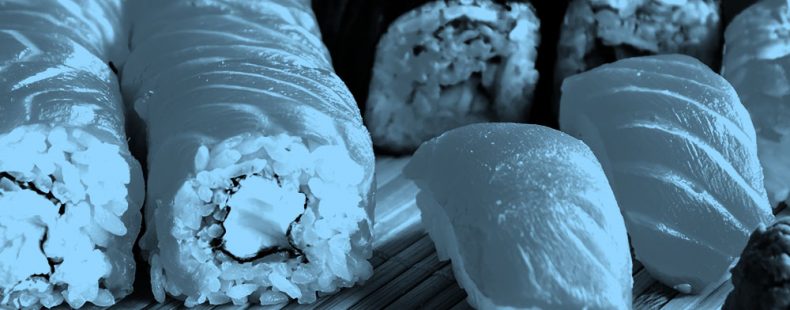If you’ve ever been to a Japanese restaurant, particularly in the US, there are certain familiar items you’re expecting to see: miso soup, tongue-tingling wasabi, warm sake, plenty of rice, and equal amounts of fish and other carefully prepared bite-sized portions. But did you know that you don’t actually need fish (uncooked or otherwise) in order to call the dish you’re eating sushi? Those little blocks of rice with bits of egg or even spam secured onto them with a strap of seaweed? Yup, still sushi!
So let’s take a bite out of history and get to the bottom of some frequently used sushi words and references!
What is sushi?
Let’s start with the reason why we’re here: sushi! Now, when most Westerners think of sushi, it conjures images of slices of raw fish and other toppings arranged neatly on or inside of bite-sized morsels of rice. Technically, the fish and toppings could be removed altogether because sushi specifically refers to the style of rice used. Sushi is cold boiled rice moistened with rice vinegar, giving it a slightly sour flavor. Originally, sushi was developed as a means of preserving raw fish, wrapping the salted fish in this specially fermented rice for up to weeks or even months.
🍣 Did you know ... ?
While many people living in the US might associate sushi as a dish that is quintessentially Japanese, the origins of the sushi-making process can be traced to Southeast Asia between the fifth and third centuries BCE. One of the first instances of describing the concept of sushi in print is credited to a fourth-century Chinese dictionary, which describes salted fish being placed in cooked rice to undergo a fermentation process. It’s estimated that sushi was likely introduced to Japan as late as the eighth century. Sushi, as we hear it in English, was first recorded in 1895–1900 from its Japanese origin of “sour, sour rice.”
What is wasabi?
If you’ve ever had wasabi paste, you’re probably feeling the hair raise off your scalp right now! A plant of the family Brassicaceae, which also includes horseradish and mustard, wasabi is a green root. Its rhizomes are ground into a paste that is used as a popular condiment to accompany sushi, sashimi, and other dishes with raw fish. Wasabi has been used for medicinal purposes at least as far back as Japan’s Nara period (710-793 CE).
Looking for more about sashimi? Read about it here.
What is daikon?
This iconic white winter radish has appeared in popular culture, including one striking rotund character in the anime feature Spirited Away (2001). Its etymology rooted in Middle Chinese, the modern word daikon [ dahy-kuhn, -kon ] is composed of the Japanese prefix for “large” (dai–) and the word for “root” (-kon). These radishes are crunchy and mostly composed of water. Daikon-oroshi (grated daikon) is frequently used as a garnish, often mixed into sauces such as ponzu. Many types of Japanese pickles are also made with daikon roots. Daikon appears in dishes throughout Asia, including China, Vietnam, the Philippines, India, and Pakistan.
What is mirin?
Mirin [ mee-reen ] is a Japanese cooking wine made from rice. Uses and cooking styles with mirin will vary heavily by region, but you’re likely to encounter it in teriyaki sauces or as a key vinegar in sushi. Mirin tends to be sweeter than sake, but with a lower alcohol content (about 14% in mirin and 20% in sake). Ranking among the essential condiments of Japanese cooking, mirin is made by combining steamed glutinous rice, cultured rice (called koji), and a distilled rice liquor. This mixture may ferment between a couple months to several years. The longer mirin ages, the darker its color becomes and the more intense its flavor will be. Mirin was first recorded in English in 1870–75. The etymology of the Japanese term is likely from Middle Chinese, with the modern components of the word breaking down into mi “taste, flavor” and rin “to remove astringency.”
What is miso?
Miso is frequently seen as a key ingredient in the soup of the same name. A fermented seasoning of soybean paste, often with rice or barley added, miso is used especially to flavor soups and sauces. In most US-based Japanese restaurants, miso soup might be served before the full order of sushi rolls or sashimi arrives. Technically, miso is intended to be eaten after the meal in order to help settle your stomach.
Like sushi, miso is believed to have been introduced to the Japanese archipelago from China, possibly coinciding with the spread of Buddhism. Around 800 CE, the modern word for miso first appeared in the Nihon Sandai Jitsuroku, a contemporary Japanese history text, which replaced the original Chinese character for one that would be used specifically to refer to Japanese miso. Different types of miso (either made with refined rice or made with barley or another grain) would be used to distinguish among ruling and subordinate classes in feudal Japan. First recorded in 1720–30, miso [ mee-soh ] is equivalent to the Korean word meju “soybean malt.”
What is nigiri?
Ah, here we are! This is probably what you were thinking of when you first thought of the word sushi. Nigiri [ni-geer-ee] is specifically the little block of rice with the slice of raw fish on it. The word itself is from an earlier incarnation, nigirizushi, or literally, “hand-pressed sushi, rolled sushi.” This refers to the process by which the dish was prepared. The Japanese verb nigiru means “to grip, grasp, or to roll with one’s hands” a lump of rice. In this case, the hand-molded rice lump is specifically sushi (-zushi) rice.
The invention of nigirizushi is credited to Hanaya Yohei, who opened his first sushi stall in 1824 on the streets of Japan’s then-capital of Edo (later to be dubbed Tokyo). With easy access to the Tokyo Bay, Yohei was able to serve his sushi with fresh fish that, while either lightly cooked or marinated, didn’t need to be salted and preserved for the long term.
What is nori?
If you’ve had sushi, you’ve probably seen the little dark strip that either holds the fish in place on the rice like a mini seatbelt or seen the dark wrapping around the chunky, cut pieces of a sushi roll. There’s the nori! Nori is seaweed having a mildly sweet, salty taste, usually dried, used in Japanese cuisine, primarily as a wrap for sushi. While the first use of nori is uncertain, it is documented as early as 702 CE in a tax code. Cultivation of nori into the sheets we typically see it in today began around the 17th-century Edo period.
First recorded in English around 1890–95, nori is a compound Japanese word constructed from no (the combining particle for “water”) and ri (“lichen, moss”) to make “edible seaweed.”
Immerse yourself in other words that have come to English straight from Japanese.
What is ponzu?
Drizzle this on any sushi roll and your tastebuds are in for a treat! Ponzu is a sauce made from citrus juice, sake, sugar, soy sauce, and red pepper. The word ponzu, which literally refers to the juice squeezed from Japanese sour oranges (typically yuzu or daidai), has a foreign root: the Dutch word pons. Pons simply means “punch,” as in the fruity beverage served at parties. The additional character for vinegar was added (-su) as the sauce took on acidic notes. It’s reasonable then that ponzu is intended to have a sweet, tangy flavor. However, as with other sauces, the ingredients behind any given ponzu can have regional variants. This means in some cases ponzu can be less sweet and have a more umami flavor. Ponzu can be used as a dipping sauce, marinade sauce, or even salad dressing.
What is maki sushi?
Remember Mr. Hanaya Yohei and his sushi stall? In the 19th century, the trend of nigirizushi as a street food boomed. To consume the food quickly and cleanly, nigirizushi was re-sculpted from a rice block to a rice cylinder with nori wrapped around it. This new makizushi was then stuffed with additional ingredients in the middle, including fish, vegetables, and condiments such as wasabi. The names of maki vary by ingredients and style. Maki are then generally sliced into round, bite-sized pieces. Today, most modern Japanese maki are fairly simple, sticking to sushi rice encompassing fish and/or vegetables with nori wrapping the exterior; however, there are plenty of specialty maki around the world that feature fillings and toppings from roe and mayonnaise to asparagus and avocado.
What is a California roll?
This particular maki is notable for being developed outside of Japan—and the original creator is a point of heated contention. Los Angeles-based sushi chefs Ken Seusa and Ichiro Mashita are two of the most frequently attributed inventors of the California sushi roll. The roll has the notable California inclusion of avocado as well as other ingredients such as cucumber and crabmeat, or imitation crabmeat, wrapped in nori and then sushi.
Like other rolls, California rolls are typically cut into circular blocks. However, distinct to the California roll at the time was the placement of nori (the seaweed) inside the maki as opposed to wrapping around the exterior of the roll. This was an attempt to make the roll more appealing to Anglo American customers who would tend to discard the nori wrap. The invention of the California roll is estimated around the late 1960s through the 1970s and in either case, helped drive the popularity of sushi in the US.
What is gunkanmaki?
This might be a less familiar word, but chances are most folks who’ve dined at a sushi restaurant have tried some sort of gunkanmaki. It’s a type of nigiri that has been wrapped in nori but lies flat, with a top (where you might usually see the wrapped ingredients) that is typically covered with roe, shredded daikon, or oysters. When placed in a row on an oblong, white plate, it’s easy to see how the little, dark cylinders of the gunkanmaki resemble its namesake: battleship. Gunkanmaki entered the sushi scene at the onset of Japan’s engagement in World War II, and its invention is credited to the Ginza Kyubey restaurant in 1941.
What is temaki?
If you’re familiar with the translation of karate (literally, “empty hand”), then you might already have a hint as to what temaki [ te-mah-kee ] means, especially now that we’ve established maki refers to most sushi rolls. Did you guess “hand roll”? You’re right! Like a standard Japanese maki, a temaki consists of vegetables and fish stuffed into sushi rice, then wrapped in a tasty, salty nori sheet. Specific to the temaki, however, is that it is then rolled into a cone shape. Essentially, this makes it easier to enjoy this type of roll by eating with one’s hands. Bon appé—wait. Correction: itadakimasu!
Take a bite out of this quiz
Have we made you hungry yet? While you look up the best sushi restaurants in your vicinity, take a moment to savor your knowledge of the rich linguistic history of sushi by taking our short quiz. You can also sample all these words any time you like by reviewing our word list … right before you sample your favorite nigiri, of course.














